If you want to know what planets are visible in the night sky tonight, this guide is for you.
Here we'll reveal what the planets are doing in the night sky throughout 2024, month by month, and which planets are not visible.
If you want to get out and see the planets tonight, you may be wondering where to start.
Finding and observing the planets of the Solar System in the night sky isn't as tricky as you think. You just need to know where to look.

Quick links
To find out what planets are in the sky tonight, jump to:
Planets in 2024
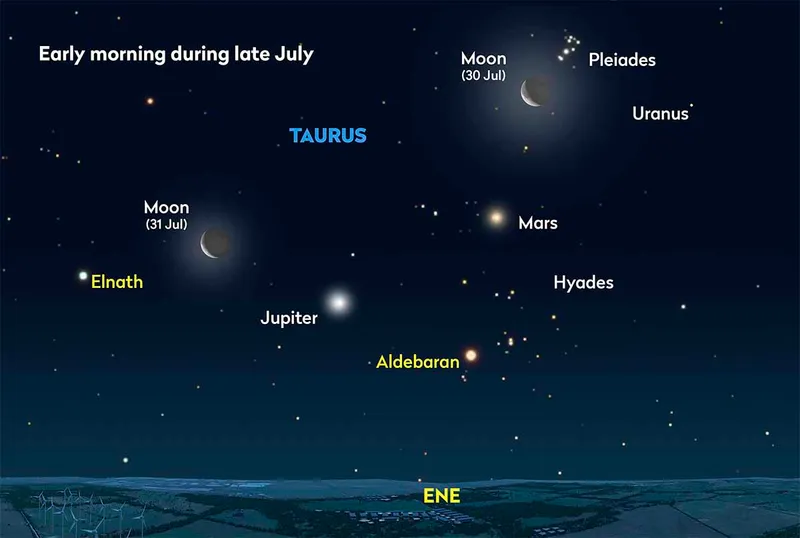
The planets tease us early in 2024, when initially well-placed Jupiter and Uranus eventually succumb to evening twilight in March.
The other superior planets are lost in the Sun’s glare. Morning Venus heads back towards the Sun at the start of 2024, lost from view in March.
However, as we head into spring the planets are rather poor. In May, it’s unlikely you’ll see any planet with the naked eye.
If planets are your thing, it may be best to get some rest in the first half of the year because the second half of 2024 will be planetary heaven.
Saturn reappears, approaching 30° altitude when due south and appearing quite edge-on through the eyepiece.
This causes interesting interactions with its largest moon Titan at the end of 2024. Saturn reaches opposition on 8 September 2024
Jupiter will be back in spectacular fashion later in 2024, appearing 60° above the horizon when due south and reaching opposition on 7 December.
Mars and Venus also burst back on the scene later in the year, Venus in the evening sky, while Mars heads for opposition in January 2025.
There are two rare lunar occultations of planets to look forward to as well: Saturn on 21 August and Mars on 18 December.
Tips for spotting planets in the night sky tonight
When a planet is in a favourable position in the evening or morning sky, it will look like a bright 'star', the most obvious point of light visible to the naked eye.
Any visible planets tonight can be found along the ecliptic, which is the line the Sun appears to traverse in the sky over the course of a day.
Since the major planets of the Solar System orbit the Sun in roughly the same plane, the ecliptic marks the path of the planets.
Is it bright, but on the wrong side of thesky to the ecliptic? Then it's not a planet.
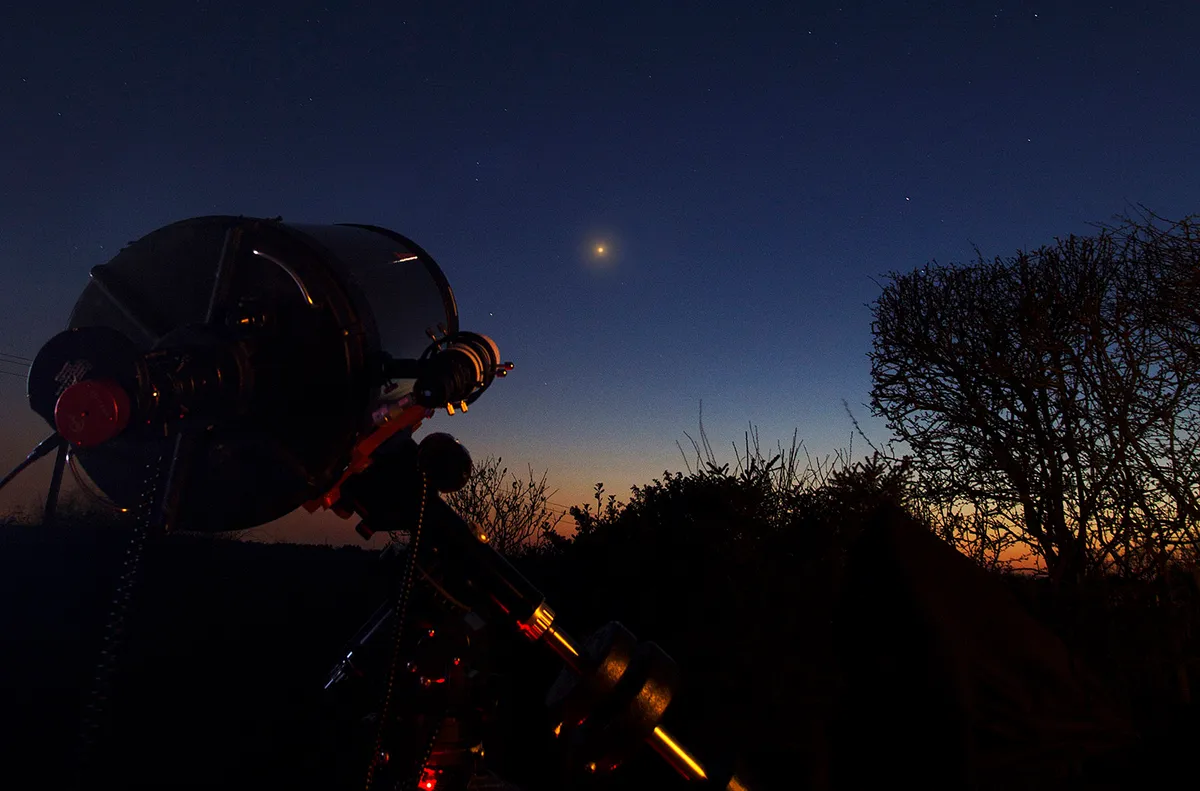
Another thing to consider is what planets are at or are near opposition, which is the best time to see a planet in the night sky.
If there's a planet near opposition tonight, that's the one to look for, as long as it's nice and high in the sky too
For more advice, read our guide on how to find planets in the night sky.
And download an astronomy and stargazing app to help you locate any planets visible in the night sky.
If you're out spotting visible planets tonight, don't forget to let your eyes adapt to the dark first.
Wait 20-30 minutes without looking at any artificial light (streetlights, your smartphone etc.) and you'll see so much more.
Once you've got to grips with this, all you need to know is what planets will be visible in the night each month, so you know what to look out for, and what dates they will be best placed.

This is where our guide below comes in. Use it throughout the coming 12 months to find out which planets are visible in the night sky in 2024, which are at opposition, and to keep track of any interesting upcoming conjunctions.
Sign up to the BBC Sky at Night Magazine e-newsletter for lunar phases and monthly astronomy highlights delivered direct to your email inbox.
You can also listen to our Star Diary podcast each week for more advice on what to see in the night sky.
If you're out spotting the planets tonight, take a pair of headphones and listen for up-to-date stargazing tips.
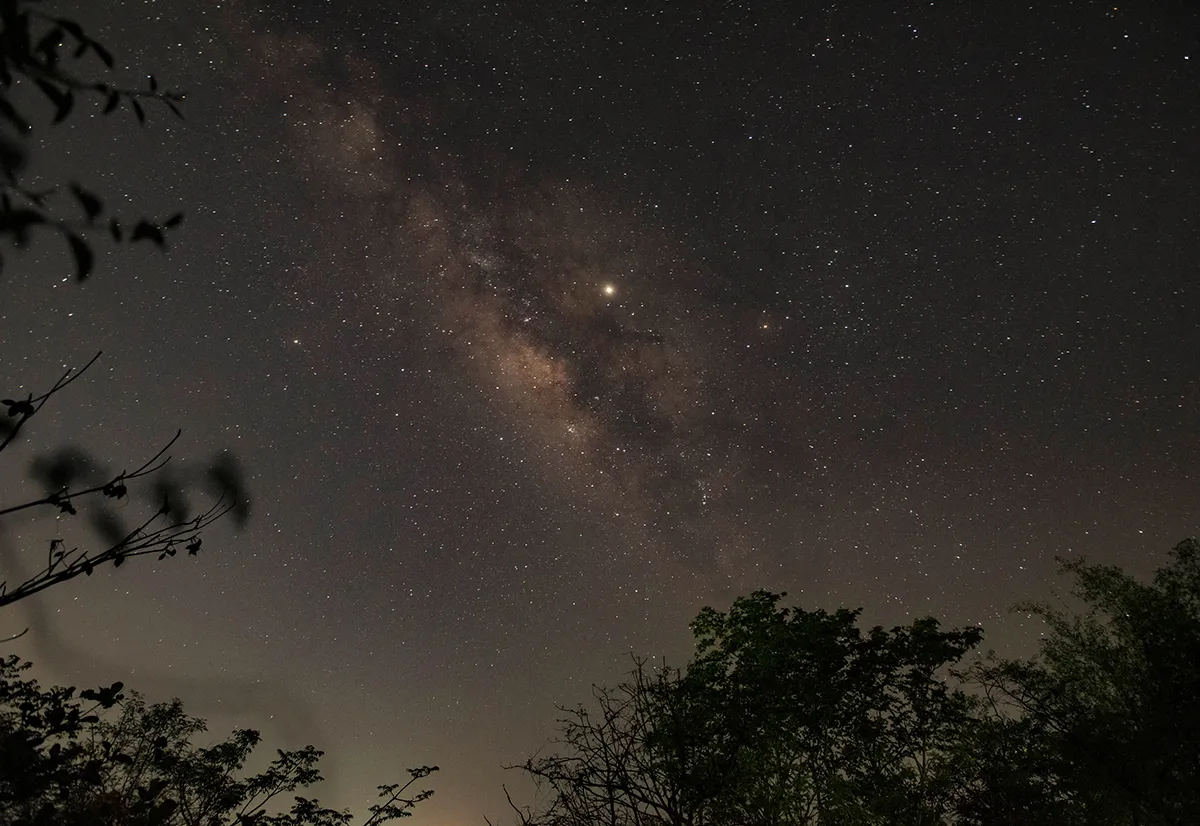
Visible planets tonight, 2024
January 2024
- 1 January: Comet 144P/Kushida lies 2° south of Uranus
- 4 January: Quadrantid meteor shower peak (am)
- 7 January: Double shadow transit of Jupiter, from 02:09 UT until setting
- 18 January: Jupiter lies 2° south of first quarter Moon (pm)
- 22 January: Jewelled Handle clair-obscur visible on the Moon (am)
Mercury
Morning planet, best early January. Close encounter with Mars on 27 January.
Venus
Morning planet, slips closer to the Sun this month.
Mars
Morning planet, hard to see well. Near Mercury on 27 January.
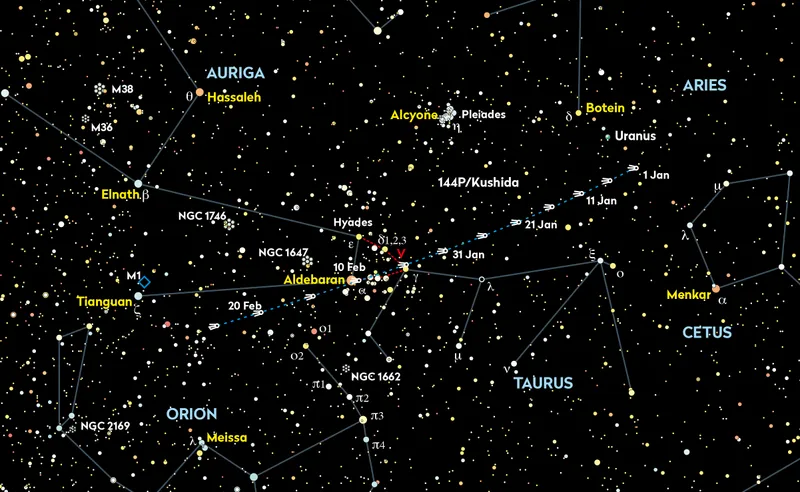
Jupiter
Evening planet edging into twilight by the end of January.
Saturn
The Ringed Planet loses ground to the evening twilight during January.
Uranus
This ice giant planet is currently well placed in the evening sky, making it one of the best planets to spot tonight.
Neptune
The position of this planet deteriorates in the evening sky over the month.
February 2024
- 7 February: Dark skies for comet 62P/Tsuchinshan
- 14 & 15 February: Waxing crescent Moon near Jupiter (pm)
- 16 February: First quarter Moon south of the Pleiades (pm)
- 17 February: Lunar X and V optimal to view around 00:40 UT
- 22 February: Venus and Mars lie 38-arcminutes apart (dawn)
Mercury
Unlikely to be seen, superior conjunction on 28 February.
Venus
Morning planet, visibility deteriorating as it approaches the Sun.
Mars
Too low and dim to be seen properly in the morning sky this month.

Jupiter
Evening planet, best placed at start of month when still at decent altitude. Position deteriorates through month.
Saturn
Not viable this month, solar conjunction on 28 February.
Uranus
Evening planet, losing altitude as darkness falls. Currently Close to Jupiter.
Neptune
Lost in the evening twilight at the end of the month.
March 2024
- 2 March: Minor planet 3 Juno reaches opposition
- 13 March: Jupiter lies near a waxing crescent Moon (pm)
- 14 March: Waxing crescent Moon lies near the Pleiades (pm)
- 26 March: Spica lies very close to the Moon (pm)
- 29-31 March: C/2021 S3 PanSTARRS crosses the Coathanger Cluster
Mercury
Evening planet, best seen later in the month.
Venus
Lost in the morning twilight this month.
Mars
Morning planet lost in twilight.
Jupiter
Hanging on in the evening sky but its visibility is deteriorating, the planet losing altitude rapidly as darkness falls.
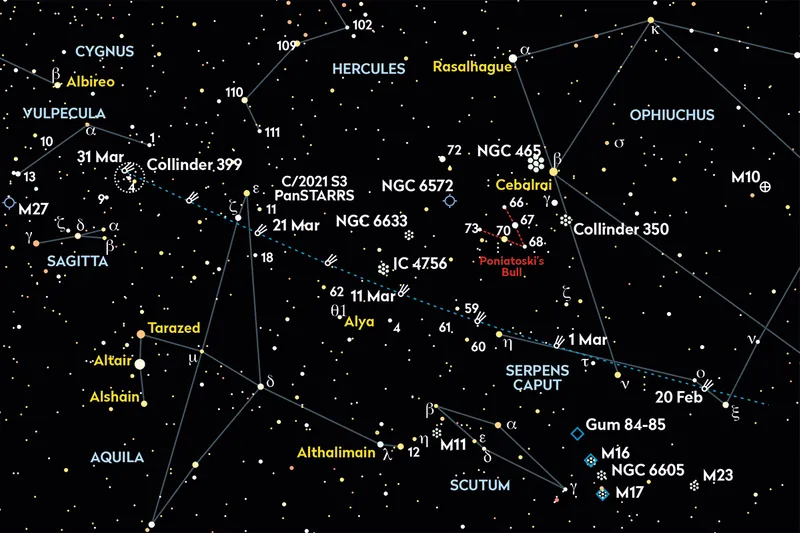
Saturn
Too close to the Sun to be seen this month.
Uranus
Evening planet, deteriorating through the month. Currently lies close to Jupiter and, like its brighter companion, is losing altitude rapidly as darkness falls.
Neptune
Not visible this month.
April 2024
- 8 April: Small partial solar eclipse visible from western UK at sunset
- 11 April: Mars and Saturn in conjunction (am)
- 20 April: Jupiter and Uranus in conjunction (pm)
- 22 April: April Lyrid meteor shower peak (unfavourable)
- 29 April: Mars and Neptune in close conjunction (am)
Mercury
Inferior conjunction on 11 April, best seen in the evening sky at the start of the month.
Venus
This planet is unlikely to be seen this month as it is too close to the Sun.
Mars
Poorly placed morning planet, which is best seen at the end of the month.
Jupiter
This planet is unlikely to be seen this month as it becomes lost in the evening twilight.
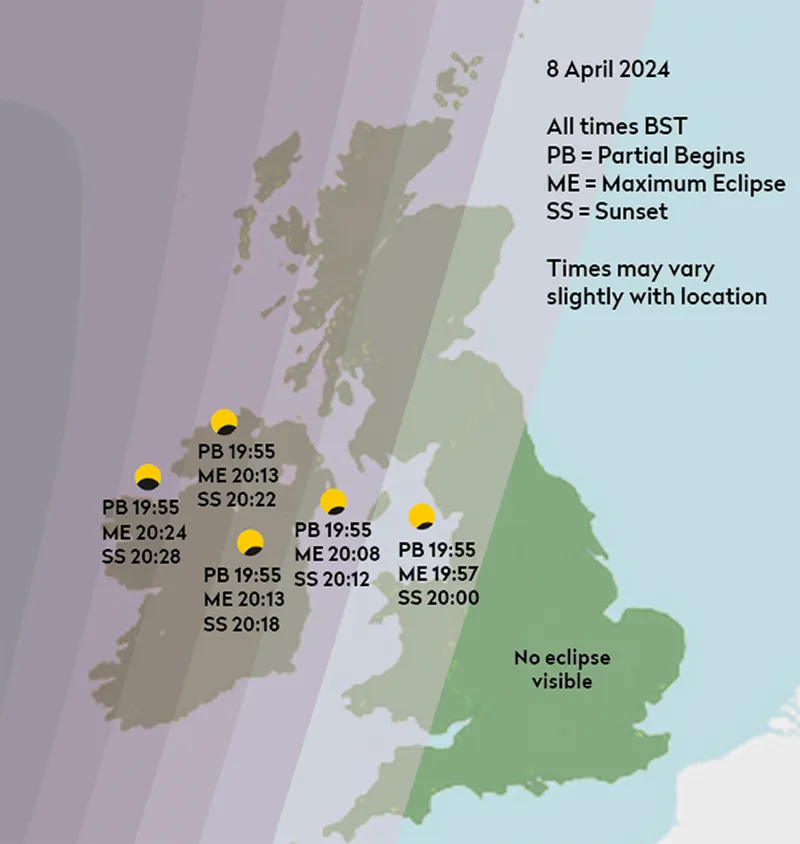
Saturn
Morning planet but poor.
Uranus
Lost to the evening glare. In conjunction with Jupiter on 20 April.
Neptune
Not visible this month.
May 2024
- 6 May: Eta Aquariid meteor shower (am)
- 8 May: Ultra-thin waxing crescent Moon lies near the Pleiades (pm)
- 14 May: Waxing crescent Moon lies near M44 the Beehive Cluster at 01:00 BST
- 17 May: Asteroid 2 Pallas reaches opposition
- 24 May: Full Moon occults M4 and is near Antares (am)
Mercury
Unlikely to be seen this month.
Venus
Unlikely to be seen this month.
Mars
Morning planet emerging from the Sun’s glare, best at the end of the month. A shallow ecliptic angle puts mag. 1.1 Mars close to the horizon, making it hard to find.
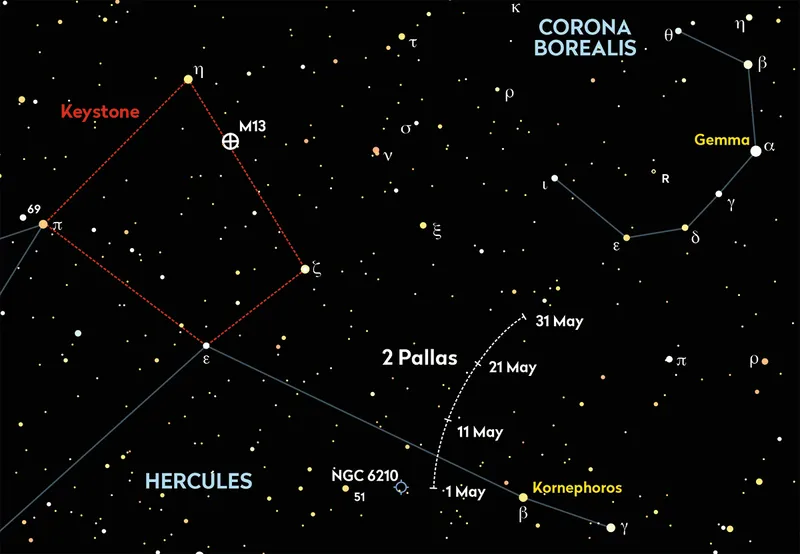
Jupiter
Solar conjunction on 18 May and unlikely to be seen this month.
Saturn
Poor visibility in the morning sky.
Uranus
Not visible this month.
Neptune
Not visible this month.
June 2024
- All month: Possibility of noctilucent cloud displays
- 3 June: Waning crescent Moon lies near Mars (am)
- 4 June: Jupiter and Mercury lie half-a-degree apart (am)
- 20 June: Northern hemisphere’s summer solstice (21:50 BST)
- 29 June: Cutlass clair-obscur effect visible on the Moon
Mercury
Superior conjunction 14 June, making it one of the best planets to see tonight. Best in the evening sky at the end of June when it can be seen shining at mag. -0.5, located 10° east of Venus.
Venus
Unlikely to be seen this month.
Mars
Improving morning planet, rises nearly three hours before sunrise at the end of June.
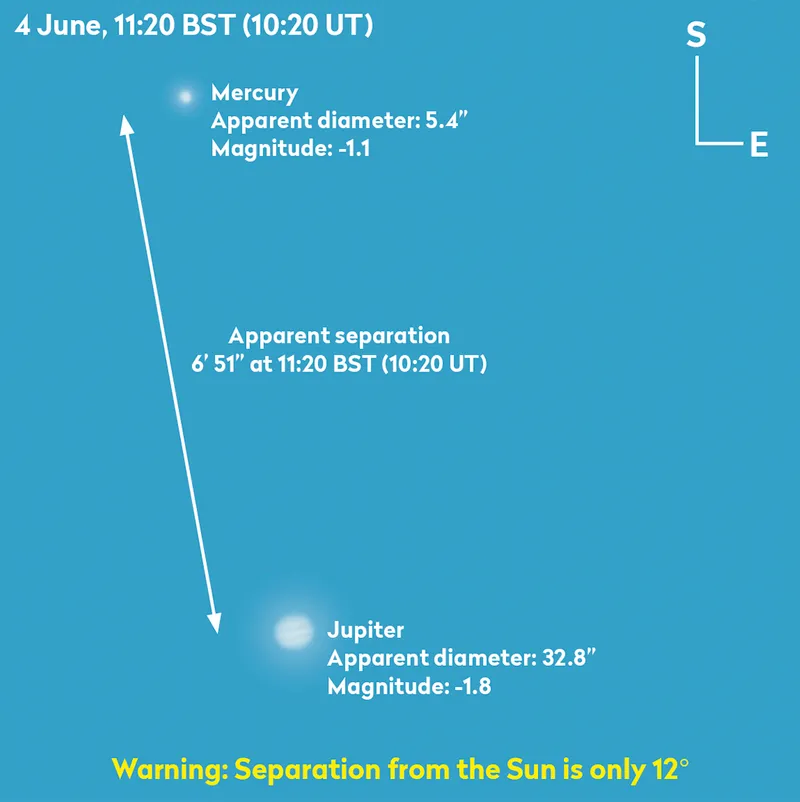
Jupiter
Improving morning planet, close daylight conjunction with Mercury on 4 June.
Saturn
Morning planet with poor visibility.
Uranus
Not visible this month.
Neptune
Not visible this month.
July 2024
- All month: Possibility of noctilucent cloud displays
- 1 July: Mars lies near the waning crescent Moon (am)
- 6 July: Ceres reaches opposition
- 15 & 16 July: Mars and Uranus in conjunction (am)
- 30 July: Mars, Jupiter, Uranus and crescent Moon in Taurus (am)
Mercury
Evening planet, not optimally placed. Best mid-month.
Venus
Evening planet, not easily visible at present.
Mars
Morning planet near Jupiter. In close conjunction with Uranus on 15 July.
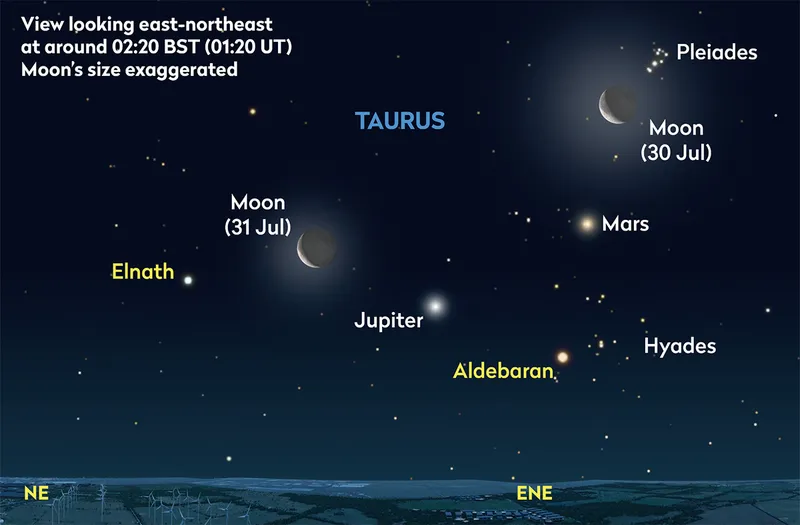
Jupiter
Improving morning planet. Impressive scenes towards end of July with Jupiter close to Mars and crescent Moon, against the stars of Taurus.
Saturn
Morning planet, best visibility occurs at the end of the month.
Uranus
Morning planet in conjunction with Mars on 15 July.
Neptune
Improving morning planet, best seen at end of July.
August 2024
- 1 August: Waning crescent Moon lies near M35 after rising (am)
- 5 August: Jupiter, Mars and Aldebaran form a right-angled triangle (am)
- 9 August: Double shadow transit of Jupiter (am)
- 12 August: Peak of the Perseid meteor shower
- 21 August: Saturn occulted by the Moon (am)
Mercury
Inferior conjunction 19 August, best in morning sky at end of month.
Venus
Evening planet, setting only 40 mins after Sun all month.
Mars
Improving morning planet, forming interesting patterns with Aldebaran and Jupiter.

Jupiter
Improving morning planet in Taurus. Reaching good altitude of nearly 40° under dark skies at end of month.
Saturn
Improving morning planet, occulted by the Moon on 21 August.
Uranus
Improving morning planet, currently near the Pleiades.
Neptune
Morning planet able to reach peak altitude, due south, in darkness from mid-August.
September 2024
- 2 September: Very thin Moon lies near Regulus (am)
- 5 September: Venus lies near 5%-lit waxing crescent Moon (pm)
- 8 September: Saturn at opposition
- 13/14 September: Excellent Ganymede shadow transit from 23:38 BST
- 18 September: Small partial lunar eclipse of the Harvest Moon (am)
Mercury
Morning planet, best on 5 September. Superior conjunction 30 September.
Venus
Evening planet, improving slowly. Best at end of month.
Mars
Improving morning planet, near open cluster M35 on 9 September.
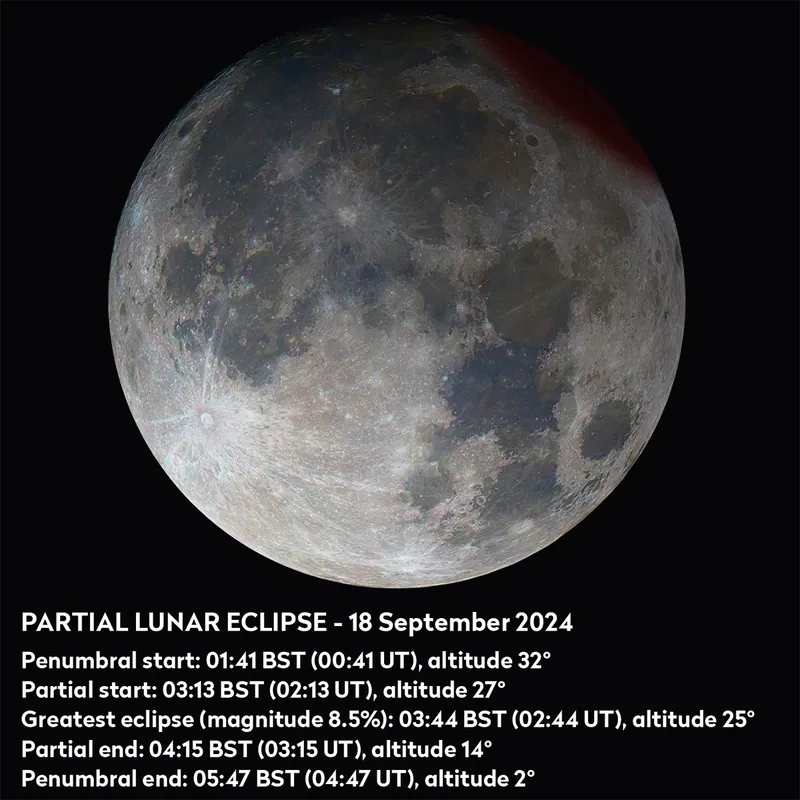
Jupiter
Excellent position at the end of September, reaching 60° altitude in darkness.
Saturn
Opposition on 8 September, well presented all month, making Saturn among the best planets to see tonight, September 2024.
Uranus
Well placed planet, able to reach 56° altitude under dark skies from mid-September.
Neptune
Opposition on 21 September and visible at peak altitude under dark skies for the whole month.
October 2024
- 5 October: Venus lies near the waxing crescent Moon (pm)
- 14 October: Saturn very near the waxing gibbous Moon (pm)
- 17 October: Perigee full Moon (supermoon)
- 19 October: Lunar occultation of the southern part of the Pleiades (pm)
- 26 October: Ganymede shadow transit of Jupiter from 23:42 BST (pm)
Mercury
Unlikely to be seen.
Venus
Evening planet, setting 90 minutes after the Sun at the end of the month.
Mars
Well-presented morning planet currently in Gemini.
Jupiter
Superbly placed planet, best at the end of October when it’s able to reach its highest altitude of nearly 60° when due south, under dark skies. One of the best planets to see tonight.
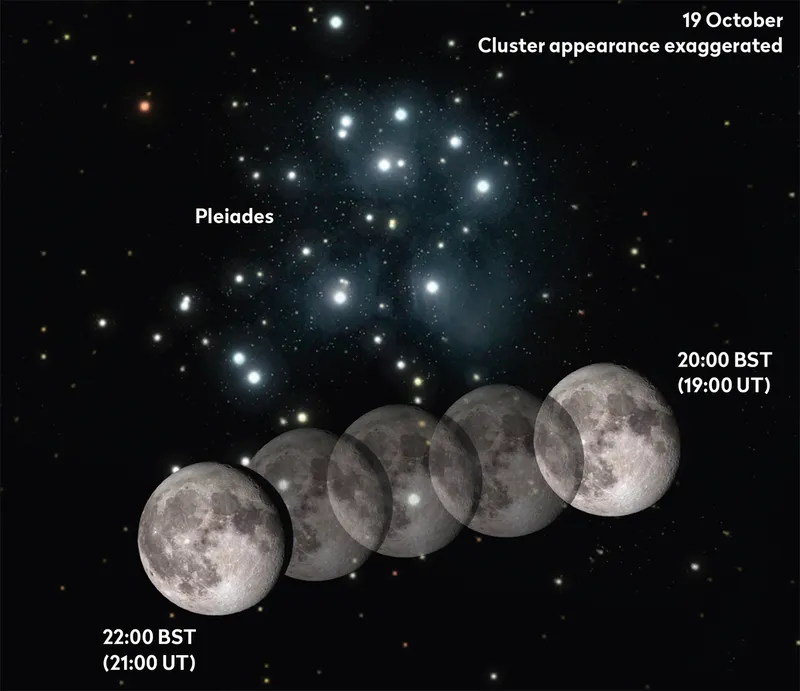
Saturn
Well-presented evening planet, reaching nearly 30° altitude when due south.
Uranus
Well-positioned planet, able to reach peak altitude, due south, in darkness all month.
Neptune
Well-presented evening planet in Pisces, visible at peak altitude under dark skies all month.
November 2024
- 1 November: Callisto lies south of Jupiter’s southern pole (am)
- 4 November: Venus near the waxing crescent Moon (pm)
- 4 November: Rare transit of Titan’s shadow on Saturn from 21:08 UT (pm)
- 17 November: Uranus reaches opposition
- 30 November: Mars lies near M44 (pm)
Mercury
Evening planet, reaches greatest eastern elongation on 15 November. Not ideally placed.
Venus
Improving evening planet, setting nearly three hours after the Sun at the end of November.
Mars
Well-placed planet. Located 2° from M44 end of month.
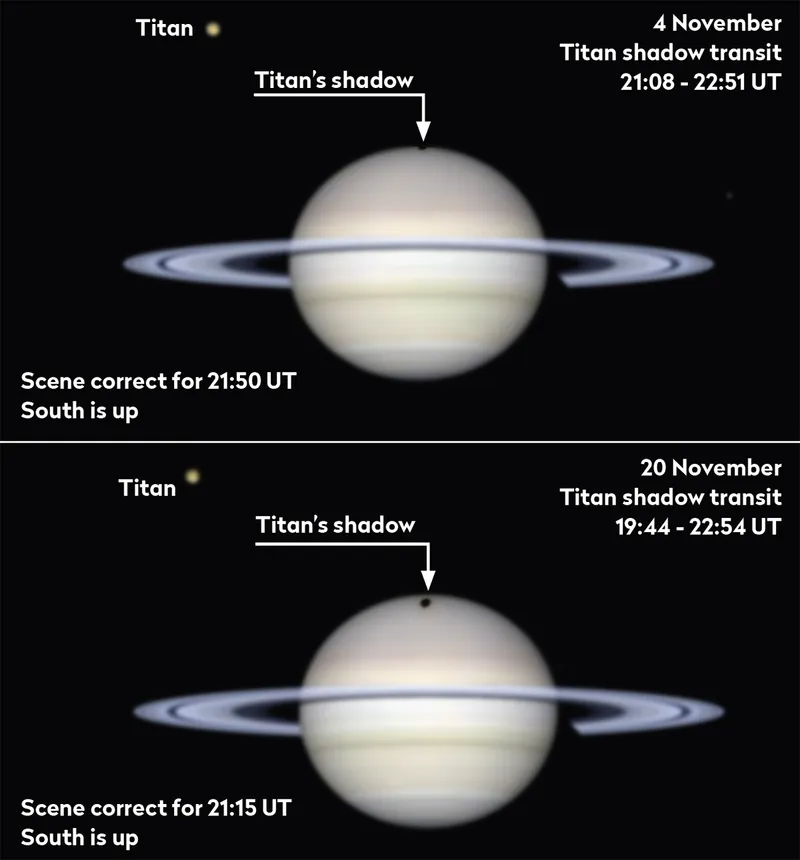
Jupiter
Approaching opposition and well presented in Taurus.
Saturn
Well-presented evening planet in Aquarius.
Uranus
Opposition on 17 November and beautifully presented all month long.
Neptune
Well-positioned evening planet that reaches peak altitude of 35° in darkness all month.
December 2024
- 6 December: Titan shadow transit on Saturn from 18:32 UT (pm)
- 7 December: Jupiter reaches opposition in Taurus
- 8/9 December: Excellent Ganymede shadow transit on Jupiter from 22:30 UT
- 18 December: Daylight lunar occultation of Mars (am)
- 22 December: Ursid meteor shower peak (am)
Mercury
Inferior conjunction on 6 December. Excellent morning planet at end of December.
Venus
Excellent position in the evening sky, setting over four hours after sunset by the end of December.
Mars
Excellent planet approaching opposition next month. Daylight occultation by Moon on 18 December.
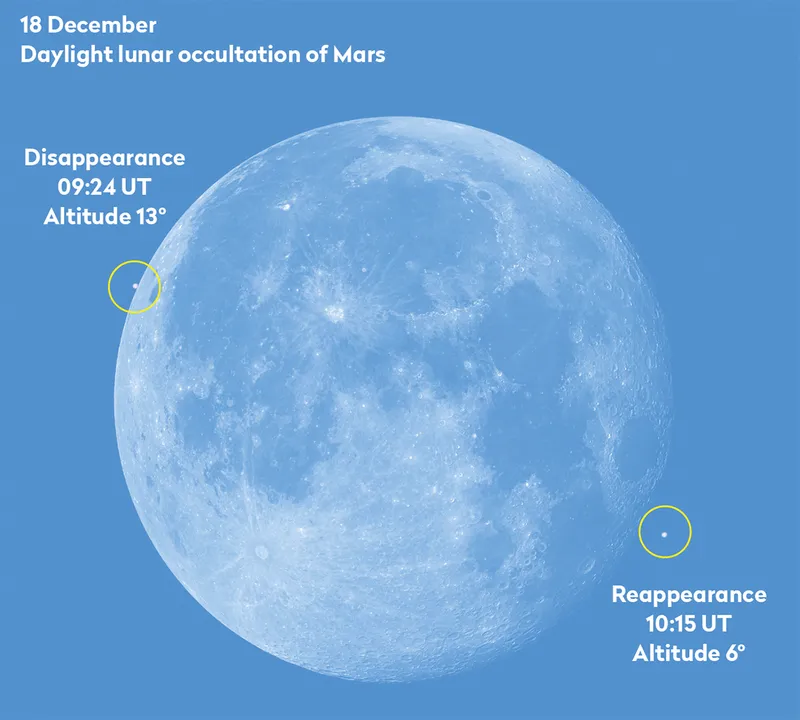
Jupiter
Opposition on 7 December. Gets to 60° peak UK altitude in dark skies all month.
Saturn
Well placed at the start of December.
Uranus
Well-placed evening planet.
Neptune
Well-placed binocular planet for most of December.
